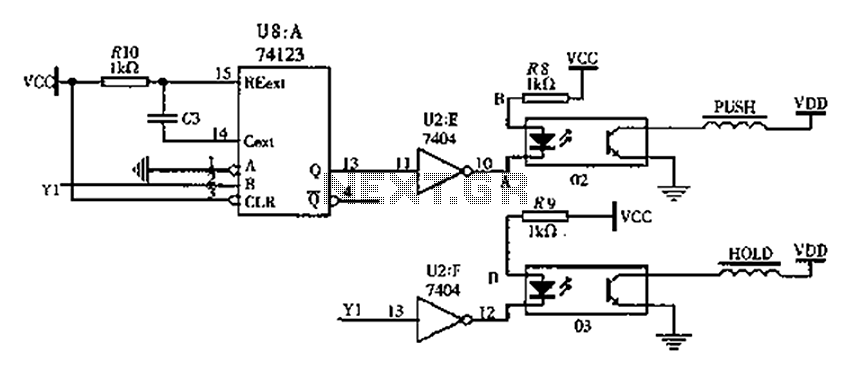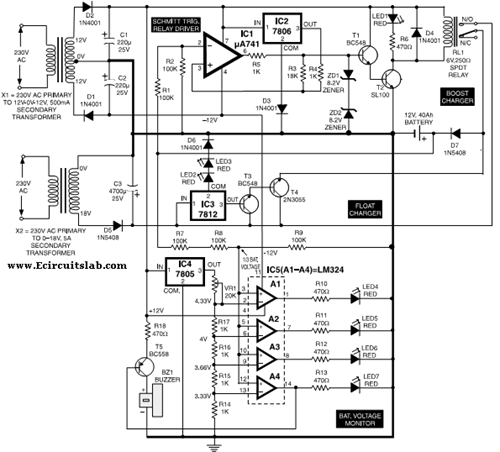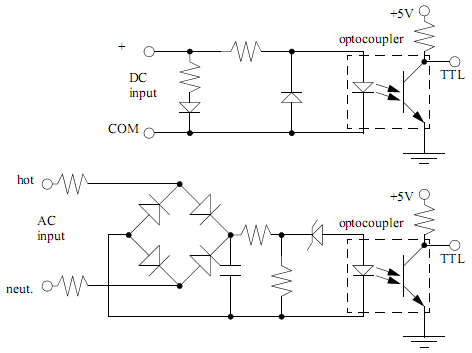
Logic Probe with Pulse Indicator Circuit

This circuit diagram represents a logic probe based on a single CMOS integrated circuit (IC). The logic probe indicates three conditions: High, Low, and Pulsing. Additionally, no LEDs will illuminate when the probe input is in a high-impedance state, which occurs when the signal is neither high nor low. The configuration of the circuit utilizes power from the logic circuit under test and is designed to operate with voltages ranging from 3 to 15 volts. The first stage, IC1a, functions as a buffer with a unique characteristic. In the absence of an input, the gate oscillates due to feedback from a 2.2MΩ resistor, resulting in an output voltage that is approximately half of the supply voltage. The High and Low logic indicator LEDs are connected through a potential divider made of two 1kΩ resistors. When there is no input, the junction voltage remains at half the supply voltage, leading to a high-impedance state where no LEDs illuminate. IC1a maintains a stable state based on the High or Low logic condition, indicated by the illumination of either the High or Low LED. The High and Low LEDs may glow dimly in response to a fast oscillator or clock signal. This behavior is managed by IC1b and IC1c, which form a monostable oscillator. The time constant is determined by a 100nF capacitor and a 4.7MΩ resistor, effectively slowing down the clock signal as the monostable is continuously triggered and retriggered. IC1d serves as a buffer to drive the pulsing LED.
The logic probe circuit is designed to provide visual feedback on digital signal levels, making it a valuable tool for troubleshooting and testing logic circuits. The use of a CMOS IC allows for a wide operating voltage range, accommodating various digital systems. The configuration ensures that the logic probe does not interfere with the circuit under test, thanks to its high-impedance state when no signal is present.
The buffer stage (IC1a) plays a crucial role in isolating the logic probe from the circuit, ensuring accurate readings without loading the tested circuit. The oscillation of IC1a when disconnected is a useful feature, as it provides an indication of the probe's operational status.
The potential divider formed by the two 1kΩ resistors is essential for determining the LED operation. In a high-impedance state, the output remains at half the supply voltage, which keeps the LEDs off. When a High or Low signal is detected, the corresponding LED illuminates, providing immediate visual feedback. The dim illumination of the LEDs in response to fast clock signals indicates the presence of pulsing signals, which can help in diagnosing signal integrity issues.
The monostable oscillator configuration created by IC1b and IC1c introduces a time delay, allowing the logic probe to filter out rapid fluctuations in the input signal. The timing components, specifically the 100nF capacitor and the 4.7MΩ resistor, set the duration of the output pulse, effectively stabilizing the LED indication in the presence of noisy or fast-changing signals.
Finally, IC1d's role as a buffer for the pulsing LED ensures that the output is capable of driving the LED without affecting the performance of the preceding stages. This design not only enhances the reliability of the logic probe but also improves its usability in various testing scenarios, making it an essential tool for electronics engineers and technicians.This is a circuit diagram for logic probe that is based on single CMOS IC. This logic probe shows three logic condition, High, Low, and Pulsing. Ind addition, there is no LED`s will glow if the probe input is neither hi or lo (the high impedance state of tri-output logic IC`s). This is the configuration of figure the circuit; This logic probe usin g power from the logic circuit under test; CMOS IC enables logic circuit is used to test using voltages from 3 to 15 volts. IC1a is used as a buffer with a difference. Under no input, i. e. the gate will oscillate due to feedback from the 2M2 resistor since the probe not connected to circuit.
IC1a output voltage is approximately half from supply voltage. The Hi and Lo logic indicator LED`s are connected to a potential divider. This potential divider consist of two 1K resistors. When there is no input, junction voltage is half supply voltage or high impedance no LED`s will glow. IC1a will rest in a permanent state because of Hi or Lo logic condition. This is indicated by either the Hi or Lo LED illuminating. Hi and Lo LEDs will light dimly with a fast oscillator or clock signal. This is the reason for IC1b and IC1c. These two gates form a mono stable oscillator, 100nF capacitor and 4M7 resistors determine the time constant.
This is effectively slowed using clock signal as the mono stable is continually triggered and retriggered. IC1d works like a buffer to drive the pulsing LED. 🔗 External reference
The logic probe circuit is designed to provide visual feedback on digital signal levels, making it a valuable tool for troubleshooting and testing logic circuits. The use of a CMOS IC allows for a wide operating voltage range, accommodating various digital systems. The configuration ensures that the logic probe does not interfere with the circuit under test, thanks to its high-impedance state when no signal is present.
The buffer stage (IC1a) plays a crucial role in isolating the logic probe from the circuit, ensuring accurate readings without loading the tested circuit. The oscillation of IC1a when disconnected is a useful feature, as it provides an indication of the probe's operational status.
The potential divider formed by the two 1kΩ resistors is essential for determining the LED operation. In a high-impedance state, the output remains at half the supply voltage, which keeps the LEDs off. When a High or Low signal is detected, the corresponding LED illuminates, providing immediate visual feedback. The dim illumination of the LEDs in response to fast clock signals indicates the presence of pulsing signals, which can help in diagnosing signal integrity issues.
The monostable oscillator configuration created by IC1b and IC1c introduces a time delay, allowing the logic probe to filter out rapid fluctuations in the input signal. The timing components, specifically the 100nF capacitor and the 4.7MΩ resistor, set the duration of the output pulse, effectively stabilizing the LED indication in the presence of noisy or fast-changing signals.
Finally, IC1d's role as a buffer for the pulsing LED ensures that the output is capable of driving the LED without affecting the performance of the preceding stages. This design not only enhances the reliability of the logic probe but also improves its usability in various testing scenarios, making it an essential tool for electronics engineers and technicians.This is a circuit diagram for logic probe that is based on single CMOS IC. This logic probe shows three logic condition, High, Low, and Pulsing. Ind addition, there is no LED`s will glow if the probe input is neither hi or lo (the high impedance state of tri-output logic IC`s). This is the configuration of figure the circuit; This logic probe usin g power from the logic circuit under test; CMOS IC enables logic circuit is used to test using voltages from 3 to 15 volts. IC1a is used as a buffer with a difference. Under no input, i. e. the gate will oscillate due to feedback from the 2M2 resistor since the probe not connected to circuit.
IC1a output voltage is approximately half from supply voltage. The Hi and Lo logic indicator LED`s are connected to a potential divider. This potential divider consist of two 1K resistors. When there is no input, junction voltage is half supply voltage or high impedance no LED`s will glow. IC1a will rest in a permanent state because of Hi or Lo logic condition. This is indicated by either the Hi or Lo LED illuminating. Hi and Lo LEDs will light dimly with a fast oscillator or clock signal. This is the reason for IC1b and IC1c. These two gates form a mono stable oscillator, 100nF capacitor and 4M7 resistors determine the time constant.
This is effectively slowed using clock signal as the mono stable is continually triggered and retriggered. IC1d works like a buffer to drive the pulsing LED. 🔗 External reference





